The global plant-based body paint pigments market, valued at USD 803.2 million in 2025 and projected to reach USD 1,223.7 million by 2035, is set to expand at a CAGR of 4.3% over the forecast period, adding USD 420.5 million in value and growing 1.52X. Consumer preference shifts toward natural, eco-friendly formulations and the rising demand across professional makeup, theatrical productions, and personal care applications drive the demand for plant-based body paint pigments. Unlike synthetic pigments, which often face criticism for toxicity or environmental concerns, plant-derived pigments are gaining traction for their safer dermatological profiles and branding flexibility, making them attractive to both mainstream and niche cosmetic manufacturers.
A key trend lies in the diversification of botanical sources, with pigments derived from turmeric, beetroot, spirulina, henna, and anthocyanins shaping supply dynamics. Regional agricultural yields directly affect the consistency and pricing of these raw materials, creating supply-side volatility while offering scope for local producers in Asia-Pacific and Latin America to establish leadership in feedstock supply. Pigment performance is equally critical, with adoption hinging on color stability, sweat resistance, and ease of removal. Products capable of maintaining vibrancy under harsh lighting or extended use, especially in entertainment and theater, are expected to capture a premium share.
Formulation innovation represents another crucial axis of growth. Blends of pigments with plant-based binders and carriers are being developed to balance vibrancy with skin safety, particularly in water-based and oil-based formats. Companies investing in dermatologically tested hypoallergenic solutions are likely to command higher price points, especially as consumers in Europe and North America demand products certified by independent safety agencies. Regulatory oversight will play a decisive role, as bodies like the FDA in the US and EFSA in the EU impose stringent guidelines on permissible natural extracts in body paints, requiring compliance in labeling, traceability, and allergen disclosures.
Market segmentation between professional and consumer adoption highlights contrasting demand cycles. Professional use in festivals, film production, and theatrical performances emphasizes performance longevity and color depth, while consumer adoption leans toward safety, convenience, and cost. Cultural factors amplify demand regionally: Asia-Pacific benefits from traditions in festival body art, while North America and Europe drive demand through cosplay, themed entertainment, and organic lifestyle preferences.
The competitive narrative is also shaped by sustainability branding. Traceability claims, organic certification, and vegan labels are being leveraged as marketing differentiators. As eco-conscious consumerism becomes embedded in purchase decisions, brands that combine botanical sourcing with ethical production are positioned to secure greater loyalty and pricing leverage. Over the next decade, the plant-based body paint pigments market will evolve from being supply-driven by botanical availability to a demand-driven ecosystem centered on product innovation, regulatory compliance, and cultural adoption patterns.
Between 2025 and 2030, the plant-based body paint pigments market is projected to expand from USD 803.2 million to USD 950.6 million, resulting in a value increase of USD 147.4 million, which represents 35.1% of the total forecast growth for the decade. This phase of development will be shaped by increasing adoption of natural cosmetic formulations, rising demand for vegan-certified pigment solutions, and growing emphasis on plant-derived colorants with enhanced safety characteristics. Professional makeup artists and body art specialists are expanding their natural product portfolios to address the growing demand for eco-friendly applications, theatrical makeup requirements, and specialty artistic applications.
| Metric | Value |
|---|---|
| Estimated Value in (2025E) | USD 803.2 million |
| Forecast Value in (2035F) | USD 1,223.7 million |
| Forecast CAGR (2025 to 2035) | 4.3% |
From 2030 to 2035, the plant-based body paint pigments market is forecast to grow from USD 950.6 million to USD 1,223.7 million, adding another USD 273.1 million, which constitutes 64.9% of the overall ten-year expansion. This period is expected to be characterized by the expansion of advanced plant extraction technologies, the integration of innovative botanical pigment formulations, and the development of multi-functional paint systems with enhanced durability characteristics. The growing adoption of clean beauty practices will drive demand for plant-based body paint pigments with superior color intensity and compatibility with sensitive skin applications across professional and consumer markets.
Between 2020 and 2025, the plant-based body paint pigments market experienced steady growth, driven by increasing demand for natural beauty products and growing recognition of plant-derived ingredients as essential components for safe makeup applications across theatrical productions, artistic performances, and personal cosmetic use. The plant-based body paint pigments market developed as consumers recognized the potential for natural pigments to provide vibrant colors while maintaining skin-friendly properties and enabling eco-conscious beauty protocols. Technological advancement in botanical extraction methods and natural colorant stabilization began emphasizing the critical importance of maintaining color vibrancy and application longevity in diverse artistic environments.
Market expansion is being supported by the increasing global demand for natural beauty solutions and the corresponding need for eco-friendly systems that can provide superior color performance and skin compatibility while enabling reduced environmental impact across various artistic and cosmetic applications. Modern makeup professionals and body art specialists are increasingly focused on implementing natural pigment technologies that can deliver vibrant colors, prevent skin irritation, and provide consistent application performance throughout complex artistic projects and diverse skin types. Plant-based body paint pigments' proven ability to deliver exceptional color intensity while maintaining skin safety, enable long-lasting applications, and support environmentally responsible beauty protocols make them essential components for contemporary artistic and cosmetic operations.
The growing emphasis on clean beauty and environmental consciousness is driving demand for plant-based body paint pigments that can support professional makeup requirements, improve color durability outcomes, and enable natural ingredient formulations. Artists' preference for products that combine effective pigmentation with skin-friendly properties and environmental responsibility is creating opportunities for innovative botanical implementations. The rising influence of natural cosmetics and organic beauty practices is also contributing to increased demand for plant-based body paint pigments that can provide botanical-derived colors, allergen-free formulations, and reliable performance across extended application periods.
The plant-based body paint pigments market is poised for steady growth and transformation. As industries across entertainment, theatrical productions, cosmetics, and artistic applications seek solutions that deliver exceptional color vibrancy, skin compatibility, and environmental responsibility, plant-based body paint pigments are gaining prominence not just as specialty cosmetics but as strategic enablers of natural beauty practices and eco-friendly artistic expression.
Rising natural cosmetics adoption in Asia-Pacific and expanding clean beauty initiatives globally amplify demand, while manufacturers are leveraging innovations in botanical extraction systems, advanced plant-based formulations, and integrated color technologies.
Pathways like premium organic formulations, professional-grade pigment systems, and specialized artistic solutions promise strong margin uplift, especially in high-end cosmetic segments. Geographic expansion and technology integration will capture volume, particularly where natural beauty practices and clean cosmetic adoption are critical. Regulatory support around cosmetic safety standards, natural ingredient requirements, and environmental compliance give structural support.
The plant-based body paint pigments market is segmented by type, application, end-use sector, distribution channel, and region. By type, the plant-based body paint pigments market is divided into liquid, solid, and gel categories. By application, it covers face & body makeup, body color cosmetics, artistic body painting, and theatrical applications. By end-use sector, it includes art institutes, individual creators, professional makeup artists, and entertainment industry. By distribution channel, the plant-based body paint pigments market is categorized into specialty stores, online platforms, beauty supply stores, and direct sales. Regionally, the plant-based body paint pigments market is divided into North America, Europe, East Asia, South Asia & Pacific, Latin America, and the Middle East & Africa.
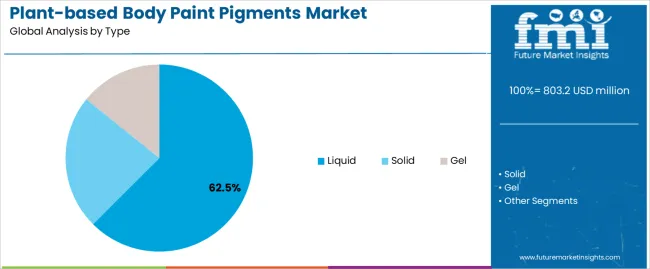
The liquid segment is projected to account for 62.5% of the plant-based body paint pigments market in 2025, reaffirming its position as the leading formulation category. Professional makeup artists and body art specialists increasingly utilize liquid plant-based pigments for their superior blending capabilities when operating across diverse artistic applications, excellent coverage characteristics, and versatility in applications ranging from theatrical makeup to professional body art creation. Liquid plant-based pigment technology's advanced flow properties and extended working time directly address the professional requirements for seamless application in complex artistic environments.
This formulation segment forms the foundation of modern professional makeup operations, as it represents the pigment type with the greatest application versatility and established market demand across multiple artistic categories and professional sectors. Manufacturer investments in enhanced botanical extraction technologies and improved color stability continue to strengthen adoption among makeup professionals and artistic institutions. With professionals prioritizing application ease and color blending capabilities, liquid plant-based pigments align with both performance requirements and creative flexibility objectives, making them the central component of comprehensive natural makeup strategies.
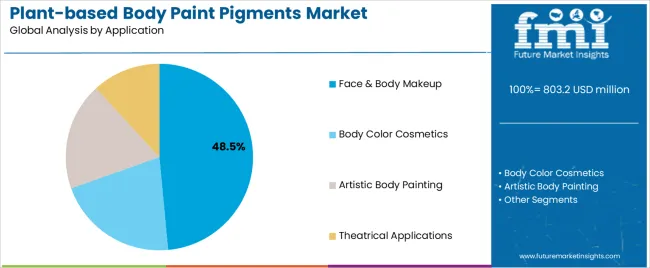
Face & body makeup applications are projected to represent 48.5% of plant-based body paint pigment demand in 2025, underscoring their critical role as the primary professional consumers of natural pigment technology for cosmetic enhancement, artistic expression, and theatrical makeup applications. Makeup professionals prefer plant-based pigments for their exceptional skin compatibility capabilities, vibrant color characteristics, and ability to provide natural coverage while ensuring safety throughout diverse cosmetic programs. Positioned as essential products for modern beauty operations, plant-based body paint pigments offer both performance advantages and skin-friendly benefits.
The segment is supported by continuous innovation in botanical pigment technologies and the growing availability of specialized formulation systems that enable variable coverage applications with enhanced color intensity and rapid application capabilities. Additionally, makeup professionals are investing in natural product portfolios to support comprehensive beauty services and artistic planning. As clean beauty demand becomes more prevalent and natural cosmetic requirements increase, face & body makeup applications will continue to dominate the end-use market while supporting advanced natural beauty utilization and skin-safe cosmetic strategies.
The plant-based body paint pigments market is advancing steadily due to increasing demand for natural cosmetic technologies and growing adoption of eco-friendly beauty solutions that provide superior skin compatibility and color performance while enabling reduced environmental impact across diverse artistic and cosmetic applications. However, the plant-based body paint pigments market faces challenges, including higher production costs compared to synthetic alternatives, limited color range availability, and the need for specialized storage and handling requirements. Innovation in botanical extraction capabilities and advanced natural formulation systems continues to influence product development and market expansion patterns.
The growing adoption of clean beauty standards, natural cosmetic formulations, and eco-friendly ingredient sourcing is enabling manufacturers to produce advanced plant-based body paint pigments with superior safety profiles, enhanced color vibrancy, and botanical-derived functionalities. Advanced natural systems provide improved skin compatibility while allowing more diverse color options and consistent performance across various application techniques and skin types. Manufacturers are increasingly recognizing the competitive advantages of plant-based pigment capabilities for market differentiation and premium positioning.
Modern plant-based pigment producers are incorporating innovative extraction methods, concentrated botanical processing, and enhanced color stabilization systems to improve pigment intensity, enable longer shelf life, and deliver value-added solutions to professional customers. These technologies improve color performance while enabling new formulation capabilities, including improved color mixing, enhanced application properties, and reduced environmental impact. Advanced extraction integration also allows manufacturers to support comprehensive natural cosmetic systems and beauty modernization beyond traditional synthetic pigment approaches.
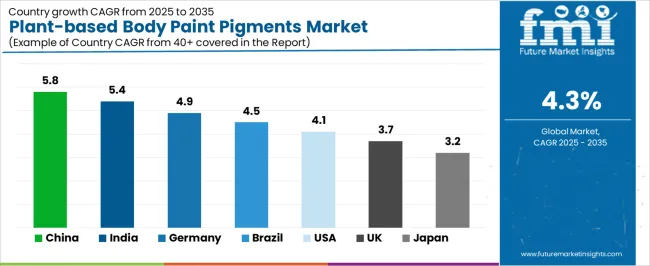
| Country | CAGR (2025-2035) |
|---|---|
| China | 5.8% |
| India | 5.4% |
| Germany | 4.9% |
| Brazil | 4.5% |
| USA | 4.1% |
| UK | 3.7% |
| Japan | 3.2% |
The plant-based body paint pigments market is experiencing steady growth globally, with China leading at a 5.8% CAGR through 2035, driven by the expanding natural cosmetics industry, growing clean beauty adoption, and significant investment in botanical extraction technology development. India follows at 5.4%, supported by traditional herbal knowledge systems, increasing natural beauty product demand, and growing entertainment industry requirements. Germany shows growth at 4.9%, emphasizing organic cosmetic innovation and advanced natural formulation development. Brazil records 4.5%, focusing on biodiversity-based ingredient sourcing and natural cosmetic expansion. The USA demonstrates 4.1% growth, prioritizing clean beauty standards and natural cosmetic excellence. The UK exhibits 3.7% growth, emphasizing natural ingredient adoption and eco-friendly cosmetic development. Japan shows 3.2% growth, supported by premium natural cosmetic initiatives and botanical ingredient concentration.
The report covers an in-depth analysis of 40+ countries, the top-performing countries are highlighted below.
Revenue from plant-based body paint pigments in China is projected to exhibit strong growth with a CAGR of 5.8% through 2035, driven by expanding natural cosmetics industry and rapidly growing clean beauty adoption supported by government initiatives promoting botanical ingredient development. The country's strong position in herbal medicine and increasing investment in natural cosmetic infrastructure are creating substantial demand for advanced plant-based pigment solutions. Major cosmetic manufacturers and beauty brands are establishing comprehensive botanical extraction capabilities to serve both domestic natural beauty demand and international clean cosmetic markets.
Revenue from plant-based body paint pigments in India is expanding at a CAGR of 5.4%, supported by the country's rich traditional knowledge of botanical ingredients, expanding Ayurvedic cosmetic sector, and increasing adoption of natural beauty solutions. The country's initiatives promoting traditional medicine commercialization and growing consumer awareness are driving requirements for advanced plant-based pigment capabilities. International suppliers and domestic manufacturers are establishing extensive extraction and production capabilities to address the growing demand for natural body paint products.
Revenue from plant-based body paint pigments in Germany is expanding at a CAGR of 4.9%, supported by the country's advanced organic cosmetic capabilities, strong emphasis on natural ingredient innovation, and robust demand for high-performance botanical formulations in professional and consumer applications. The nation's mature cosmetic industry and quality-focused operations are driving sophisticated plant-based pigment systems throughout the beauty sector. Leading manufacturers and research institutions are investing extensively in extraction technologies and natural formulation development to serve both domestic and international markets.
Revenue from plant-based body paint pigments in Brazil is growing at a CAGR of 4.5%, driven by the country's exceptional biodiversity resources, growing natural cosmetic sector, and increasing investment in botanical ingredient development. Brazil's vast rainforest resources and commitment to natural product commercialization are supporting demand for innovative plant-based pigment solutions across multiple cosmetic segments. Manufacturers are establishing comprehensive extraction capabilities to serve the growing domestic market and natural ingredient export opportunities.
Revenue from plant-based body paint pigments in the USA is expanding at a CAGR of 4.1%, supported by the country's advanced clean beauty sector, strategic focus on natural cosmetic innovation, and established organic ingredient capabilities. The USA's cosmetic industry leadership and regulatory framework are driving demand for plant-based pigments in professional makeup, entertainment industry, and consumer cosmetic applications. Manufacturers are investing in comprehensive research development to serve both domestic clean beauty markets and international natural cosmetic applications.
Revenue from plant-based body paint pigments in the UK is growing at a CAGR of 3.7%, driven by the country's focus on natural cosmetic advancement, emphasis on clean beauty innovation, and strong position in organic ingredient development. The UK's established beauty innovation capabilities and commitment to natural product development are supporting investment in advanced plant-based technologies throughout major cosmetic regions. Industry leaders are establishing comprehensive botanical ingredient systems to serve domestic beauty operations and specialty international applications.
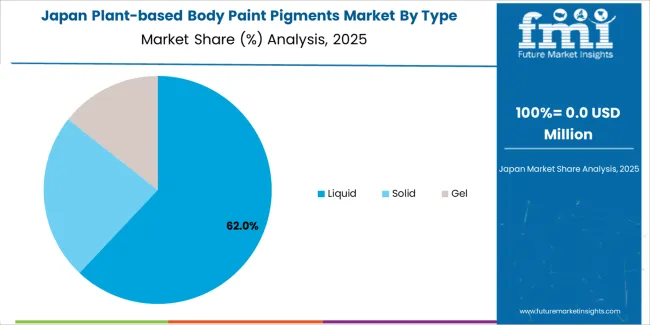
Revenue from plant-based body paint pigments in Japan is expanding at a CAGR of 3.2%, supported by the country's premium natural cosmetic initiatives, growing botanical ingredient sector, and strategic emphasis on high-quality natural product development. Japan's advanced cosmetic technology capabilities and integrated beauty systems are driving demand for sophisticated plant-based pigments in luxury cosmetics, professional applications, and specialized beauty treatments. Leading manufacturers are investing in specialized capabilities to serve the stringent requirements of premium natural cosmetics and high-end beauty industries.
The plant-based body paint pigments market in Europe is projected to grow from USD 142.5 million in 2025 to USD 201.8 million by 2035, registering a CAGR of 3.5% over the forecast period. Germany is expected to maintain its leadership position with a 32.8% market share in 2025, growing slightly to 33.2% by 2035, supported by its strong organic cosmetic sector, advanced natural ingredient capabilities, and comprehensive botanical extraction industry serving diverse plant-based pigment applications across Europe.
France follows with a 19.2% share in 2025, projected to reach 19.6% by 2035, driven by robust demand for natural cosmetics in luxury beauty, premium makeup applications, and artistic formulations, combined with established cosmetic innovation infrastructure and clean beauty expertise. The United Kingdom holds a 16.5% share in 2025, expected to reach 16.8% by 2035, supported by strong natural cosmetic sector and growing clean beauty activities. Italy commands a 12.1% share in 2025, projected to reach 12.4% by 2035, while Spain accounts for 8.8% in 2025, expected to reach 9.1% by 2035. The Netherlands maintains a 5.2% share in 2025, growing to 5.3% by 2035. The Rest of Europe region, including Nordic countries, Eastern Europe, Belgium, Poland, and other nations, is anticipated to maintain momentum, with its collective share moving from 5.4% to 3.6% by 2035, attributed to increasing natural cosmetic adoption in Eastern Europe and growing botanical ingredient penetration in Nordic countries implementing advanced clean beauty programs.
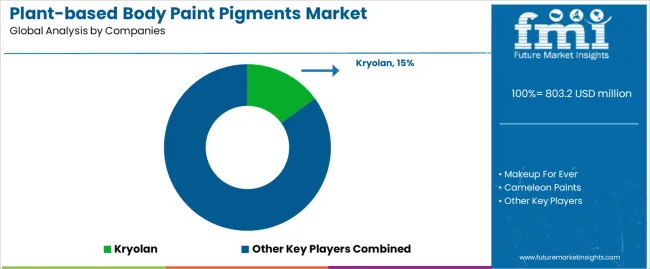
The plant-based body paint pigments market is characterized by competition among established cosmetic manufacturers, specialized natural ingredient producers, and integrated clean beauty solutions providers. Companies are investing in botanical extraction technology research, color formulation optimization, natural pigment system development, and comprehensive product portfolios to deliver consistent, high-performance, and application-specific plant-based body paint solutions. Innovation in organic certification systems, botanical sourcing integration, and performance enhancement is central to strengthening market position and competitive advantage.
Makeup For Ever leads the plant-based body paint pigments market with a strong market share, offering comprehensive plant-based pigment solutions, including advanced natural formulations with a focus on professional and theatrical applications. Cameleon Paints provides specialized body art capabilities with an emphasis on natural ingredient systems and eco-friendly artistic operations. TAG Body Art delivers innovative artistic products with a focus on botanical formulations and professional creative services. Paradise Makeup specializes in theatrical applications and plant-based pigment technologies for entertainment industry requirements. Diamond FX focuses on professional makeup equipment and integrated natural solutions. Kryolan offers specialized pigment platforms with emphasis on professional theatrical and commercial applications.
| Items | Values |
|---|---|
| Quantitative Units (2025) | USD 803.2 million |
| Type | Liquid, Solid, Gel |
| Application | Face & Body Makeup, Body Color Cosmetics, Artistic Body Painting, Theatrical Applications |
| End-Use Sector | Art Institutes, Individual Creators, Professional Makeup Artists, Entertainment Industry |
| Distribution Channel | Specialty Stores, Online Platforms, Beauty Supply Stores, Direct Sales |
| Regions Covered | North America, Europe, East Asia, South Asia & Pacific, Latin America, Middle East & Africa |
| Countries Covered | China, India, Germany, Brazil, United States, United Kingdom, Japan and 40+ countries |
| Key Companies Profiled | Makeup For Ever, Cameleon Paints, TAG Body Art, Paradise Makeup, Diamond FX, and Kryolan |
| Additional Attributes | Dollar sales by type and application category, regional demand trends, competitive landscape, technological advancements in botanical extraction systems, natural formulation development, organic certification innovation, and clean beauty integration |
The global plant-based body paint pigments market is estimated to be valued at USD 803.2 million in 2025.
The market size for the plant-based body paint pigments market is projected to reach USD 1,223.7 million by 2035.
The plant-based body paint pigments market is expected to grow at a 4.3% CAGR between 2025 and 2035.
The key product types in plant-based body paint pigments market are liquid, solid and gel.
In terms of application, face & body makeup segment to command 48.5% share in the plant-based body paint pigments market in 2025.






Full Research Suite comprises of:
Market outlook & trends analysis
Interviews & case studies
Strategic recommendations
Vendor profiles & capabilities analysis
5-year forecasts
8 regions and 60+ country-level data splits
Market segment data splits
12 months of continuous data updates
DELIVERED AS:
PDF EXCEL ONLINE
Body Armor Plates Market Size and Share Forecast Outlook 2025 to 2035
Body Composition Monitor and Scale Market Size and Share Forecast Outlook 2025 to 2035
Body Tape Market Size and Share Forecast Outlook 2025 to 2035
Body Blurring Cosmetics Market Size and Share Forecast Outlook 2025 to 2035
Body Contouring Market Size and Share Forecast Outlook 2025 to 2035
Body Fat Reduction Market Growth - Trends & Forecast 2025 to 2035
Body Armor Market Analysis - Size, Share & Forecast 2025 to 2035
Body-Worn Temperature Sensors Market Analysis by Type, Application, and Region through 2025 to 2035
Body Fat Measurement Market Analysis - Trends, Growth & Forecast 2025 to 2035
Body Slimming Devices Market Analysis by Product, End-User and Region through 2035
Leading Providers & Market Share in Body Augmentation Fillers
Body Firming Creams Market Growth & Forecast 2025-2035
Body Luminizer Market Trends & Forecast 2025 to 2035
Body Scrub Market Growth & Forecast 2025 to 2035
Body Dryer Market
Body In White Market
Antibody Specificity Testing Market Size and Share Forecast Outlook 2025 to 2035
Antibody Therapy Market Insights - Growth, Demand & Forecast 2025 to 2035
Antibody Profiling Market Analysis - Size, Share, & Forecast Outlook 2025 to 2035
Antibody Purification Service Market - Growth, Demand & Forecast 2025 to 2035

Thank you!
You will receive an email from our Business Development Manager. Please be sure to check your SPAM/JUNK folder too.
Chat With
MaRIA